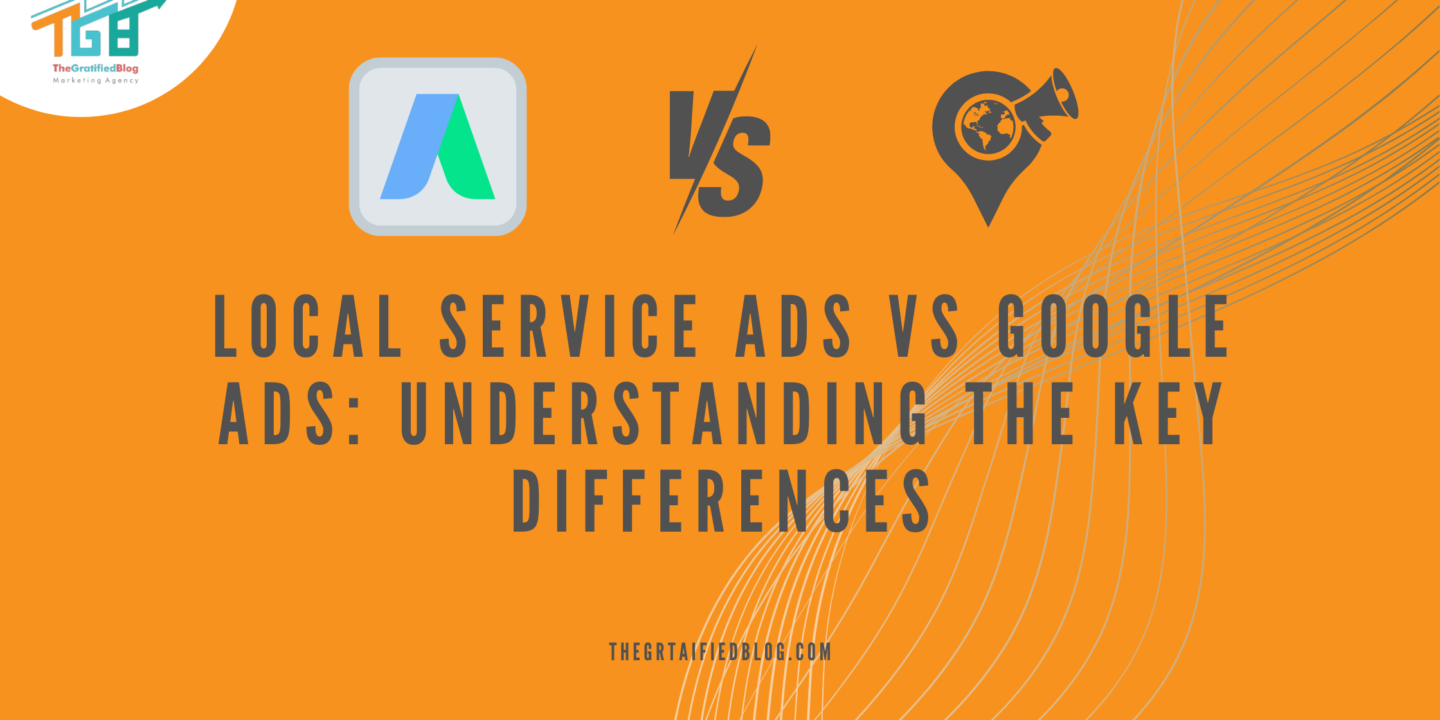
In the swiftly evolving digital marketing realm, businesses are continually searching for the most effective ways to reach their target audience. Among the myriad advertising options available, Local Service Ads and Google Ads stand out as two powerful tools for capturing potential customers’ attention. However, when choosing the right strategy for your business, the debate of “local service ads vs Google ads” often arises.
Gaining insight into the subtleties and advantages of each can assist you in making an informed decision and maximizing your advertising efforts. In this blog, we’ll delve into the specifics of Local Service Ads vs Google Ads, comparing their features, advantages, and ideal use cases to help you determine the best fit for your business.
So, let’s begin by grasping the fundamentals of both approaches
Definition Of Local Service Ads (LSAs)
Local Service Ads (LSAs) are a type of advertisement explicitly designed for service-based businesses to connect with local customers searching for their services.
These advertisements are displayed prominently at the top of Google search results when users seek local services. They display the business’s name, contact information, and customer ratings.
How LSAs Work?
- Business Verification: To use LSAs, businesses must undergo a verification process with Google, ensuring they are legitimate and trustworthy. This includes background checks and licensing verification.
- Ad Placement: LSAs appear at the top of search results for relevant local service queries once verified. They are visually distinct, featuring a prominent “Google Guaranteed” badge, business name, phone number, and customer reviews.
- Lead Generation: Potential customers can contact the business directly through the ad by clicking on it or calling the phone number provided. This streamlined process helps connect customers with service providers quickly.
- Pay-Per-Lead Model: Unlike traditional pay-per-click (PPC) ads, LSAs operate on a pay-per-lead model, meaning businesses only pay when customers contact them through the ad.
Benefits of Using LSAs
- Higher Lead Quality: LSAs generate higher-quality leads because they connect businesses with customers actively seeking their specific services. This targeted approach often results in better conversion rates and more meaningful customer interactions.
- Pay-Per-Lead Model: The pay-per-lead pricing structure ensures businesses only pay for actual leads, making LSAs a cost-effective advertising option. This model minimizes the chance of expending funds on clicks that do not convert into leads.
- Trust Badges and Reviews: LSAs feature “Google Guaranteed” badges and customer reviews, enhancing the credibility and trustworthiness of the business. These elements help build customer confidence and increase the likelihood of choosing the advertised service.
Definition Of Google Ads
Google Ads is an advertising platform developed by Google for digital marketing. It enables advertisers to craft ads that reach their target audience and potential customers across the vast Google network.
This includes Google search results, YouTube, Google Display Network, and other partner sites. Advertisers compete for keywords and pay for every click they receive (pay-per-click) or impression (cost-per-thousand impressions), allowing them to attract website visitors and generate potential leads or sales.
How Google Ads Work?
- Keyword Bidding: Advertisers select keywords relevant to their products or services and bid on them. When users search for these keywords, ads may appear in the search results or across the Google network.
- Ad Creation: Advertisers create various types of ads, including text ads for search results, display ads for websites, and video ads for YouTube. These ads attract potential customers and encourage clicks or other desired actions.
- Ad Auction: Google uses an auction system to determine which ads are shown and in what order. The auction considers the bid amount, ad quality, and expected impact of ad extensions to ensure users a fair and relevant ad experience.
- Performance Tracking: Advertisers can track the effectiveness of their ads via Google Ads’ detailed analytics and reporting tools. This data helps optimize campaigns by adjusting bids, targeting, and ad content to improve results.
Benefits of Using Google Ads
- Broad Reach and Flexibility: Google Ads allows businesses to target a broad audience across various platforms, including Google Search, YouTube, and the Google Display Network. This extensive reach ensures that companies can connect with potential customers wherever they are online.
- Various Ad Formats: Google Ads offers a variety of ad formats to suit different marketing goals and creative strategies. Advertisers can use search, display, video, and shopping ads, providing flexibility in presenting their products or services to potential customers.
- Detailed Targeting Options: Google Ads provides advanced targeting options, enabling advertisers to reach specific demographics, interests, locations, and behaviors. This detailed targeting ensures that ads are shown to the most relevant audience, increasing the likelihood of engagement and conversions.
Now that you have a grasp of both fundamentals, let’s delve deeper into the specifics of local service ads versus Google ads.
Local Service Ads Vs Google Ads: Key Differences
Cost Structure (Pay-Per-Lead Vs Pay-Per-Click)

Local service ads (LSAs) use a pay-per-lead model, Meaning businesses are charged only when a potential customer reaches out to them directly via the ad. This model ensures that advertisers pay for tangible leads rather than just clicks.
In contrast, Google Ads operates on a pay-per-click (PPC) model, where businesses pay for each click on their ad, regardless of whether the click leads to a conversion results in a lead or sale. This can sometimes lead to higher costs without guaranteed conversions.
Ad Placement And Visibility
LSAs are prominently placed at the top of Google search results for local service queries, often accompanied by a “Google Guaranteed” badge. This prime placement and visual distinction make them easily noticeable to users looking for local services.
On the other hand, Google Ads appear in various locations depending on the ad type, including at the top or bottom of search results across YouTube and the Google Display Network. While Google Ads have a broad reach, their visibility can vary based on the ad format and competition.
Targeting Options

Google Ads offers extensive targeting options, including demographics, interests, keywords, geographic locations, and device types. This allows advertisers to fine-tune their campaigns to reach specific audience segments.
LSAs, however, have more limited targeting options, primarily focusing on geographic location and service type. This makes LSAs highly effective for local businesses looking to attract nearby customers but less flexible than Google Ads in broader or more diverse targeting.
Lead Quality And Conversion Rates

Leads generated through LSAs are of higher quality because they come from users actively searching for specific local services and are pre-qualified through Google’s verification process. This frequently leads to increased conversion rates and more meaningful customer interactions.
Google Ads can also generate high-quality leads, but the broad targeting options and PPC model can sometimes lead to lower conversion rates if the ads are not finely tuned to reach the right audience.
Industry And Business Type Suitability
LSAs are well-suited for service-based businesses such as plumbers, electricians, cleaners, and other local service providers. They are designed to connect customers with companies that offer specific services in their local area. With their diverse ad formats and extensive targeting options,
Google Ads are suitable for various industries and types of businesses, including e-commerce and retail, entertainment, and technology. This flexibility makes Google Ads a versatile option for businesses with varying advertising needs.
Trust And Credibility Factors
LSAs often include trust badges like “Google Guaranteed,” enhancing businesses’ credibility and instilling trust in potential customers. While offering credibility through the Google platform, Google Ads may have different explicit trust-building elements, potentially impacting user perceptions and click-through rates.
Factors To Consider When Choosing Between LSAs And Google Ads
- Business Type and Industry: Consider whether your business is service-based and caters to local customers (favoring LSAs) or operates in a broader market with diverse offerings (favoring Google Ads).
- Advertising Budget: Evaluate your budgetary constraints and determine which platform aligns better with your budgeting goals, considering factors like cost-per-lead in LSAs versus cost-per-click in Google Ads.
- Desired Reach and Targeting: Determine the geographic reach and specificity of targeting needed for your advertising campaigns. LSAs are ideal for local targeting, while Google Ads offer broader reach and detailed targeting options.
- Lead Generation Goals: Define your lead generation objectives, including the volume of leads required and the desired quality level, as LSAs often prioritize higher-quality leads from local searches, whereas Google Ads can generate leads across a broader audience spectrum.
Conclusion
Now that you comprehend the essential distinctions between Local Service Ads and Google Ads, it’s time to take action and implement the advertising strategy to achieve the outcomes necessary for your business. Waiting only delays the opportunity to leverage the strengths of each platform and maximize your advertising efforts. Feel free to choose the best option with your objectives and start reaping the benefits of targeted, effective advertising today.
However, if you still have any questions related to the blog, please feel free to leave them in the comments section below. We will be happy to answer them.
Thank you for reading 🙂








No Comments